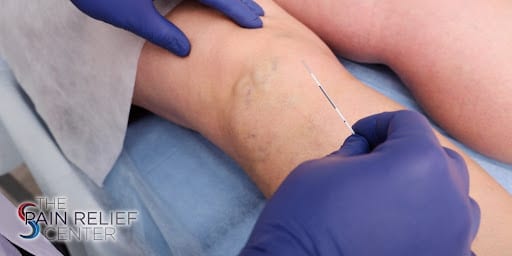Continuous Catheter Nerve Block
Home » Treatments » Continuous Catheter Nerve Block
TREATMENT OPTIONS

At The Pain Relief Center, we pride ourselves on offering a wide variety of pain control and pain management options to fit an even wider variety of conditions. After certain types of surgery, many patients benefit from peripheral nerve blocks that help control pain. In fact, many orthopedic surgeons recommend that their patients receive a take-home nerve block catheter for their pain. They can be a great alternative to oral pain medicine. If you suffer from chronic pain after your surgery, The Pain Relief Center has a solution for you. To schedule an appointment with our Frisco pain management doctor, please call 214-709-1904 today.
What Is a Continuous Catheter Nerve Block?
A nerve block catheter, also called a continuous peripheral nerve block or perineural catheter, is one popular method of achieving pain relief after surgery. The catheter itself is a long, thin tube. The doctor inserts the tube under the skin by using a small needle. Once the catheter is in place, it delivers numbing medicine to the nerves in the surrounding area. In general, the pain medication lasts anywhere from two to four days. The type of local anesthetic chosen depends largely on the type of surgery you underwent.
How Do Nerve Block Catheters Work?
As a patient, it’s incredibly important to understand how a nerve block catheter works. This is because you’ll be returning home with the catheter, and therefore you must learn to take care of it. The first step to achieving this is understanding its parts and their functions.
The catheter itself is the portion that delivers the pain medication into your body. It is the very end of the plastic tubing, plus the needle. The tubing leads to the infusion pump, which is housed in a carrying case with the reservoir of pain medicine. The catheter stays in place on the skin with the help of liquid adhesive and tape.
You do not need to do anything more once the catheter is in place. The infusion pump controls the delivery of pain medication automatically. Some patients have the option to receive another dose of pain medicine by pressing a button on the device. However, this button locks for a specified amount of time before it can be pushed again.
Where Can Nerve Block Catheters Be Placed?
This largely depends on the type of surgery you had. Different locations target different nerves. If you had shoulder surgery, the catheter could be placed in your neck. They can also be placed below your clavicle for arm surgery, behind your knee for ankle or foot surgery, or even in the thigh portion of the leg for knee surgery.
To determine the right placement for you, we recommend speaking with a pain relief specialist. We will evaluate your pain management needs and develop a treatment plan that works for you.
What Pain Medicine Is Used in a Continuous Catheter Nerve Block?
In general, a nerve block catheter administers only local anesthetics or regional anesthesia. These catheters do not administer opioid pain medications. This is largely due to the fact that the catheters serve to avoid the use of oral pain medication and opioids. Certain oral pain medications, such as opioids, are very powerful and highly addictive. For this reason, many prefer a local anesthetic.
What Conditions Does a Continuous Catheter Nerve Block Treat?
Aside from being used after undergoing surgery, peripheral nerve blocks are effective in managing chronic pain caused by certain medical conditions. Below, we list some of the symptoms and conditions that may call for the use of a peripheral nerve block.
- Treating abdominal wall pain during pregnancy
- Back pain and low back pain
- Chronic pain
- Diabetic neuropathy
- Pain related to certain types of cancer
- Neck pain
- Brachial plexus neuropathy
- CRPS or complex regional pain syndrome
- Phantom limb pain
- Trigeminal neuralgia
Remember that continuous peripheral nerve blocks have many uses. If you suffer from chronic pain due to recent surgery or due to an underlying condition, nerve blocks may be an option for you.
What Patients May Benefit from a Peripheral Nerve Block Catheter?
This is an important question that should be answered by your healthcare provider. Different pain treatments work for different patients. Therefore, your pain management doctor should evaluate you to determine if you are a good candidate for nerve blocks. Some of the factors we consider include the source of your pain as well as whether or not you have someone to help with your pain management at home.
Benefits of a Nerve Block Catheter
Nerve blocks are highly beneficial for a number of reasons. Below, we outline several reasons why nerve blocks may be a good choice for patients experiencing pain.
- They help with any pain experienced after surgery.
- They are a good alternative to strong pain pills and opioids.
- Additionally, this reduces the risk of opioid dependence or addiction.
- It may promote a faster recovery.
- You may be able to leave the hospital much sooner after your procedure.
Importantly, the medications in the nerve block are not as strong as what you would receive under general anesthesia. Some patients still experience a little pain when the stronger anesthesia wears off. However, this discomfort should fade once your peripheral nerve block begins to administer the medication.
What to Expect When You Have a Nerve Block Catheter

Your doctor will keep you informed in terms of what to expect with your catheter and infusion pump. Below, we list a few things you may experience at or around the catheter site after your catheter insertion.
- Some patients experience fluid leaking from their catheters. More than likely, this is just the anesthesia leaking out. This is a normal occurrence and does not indicate any issues with the catheter. Tell your doctor if your catheter or infusion pump starts leaking.
- Although your doctor should warn you about being careful with the catheter, sometimes accidents happen. If you or someone else accidentally dislodges the catheter, contact your doctor. Take the catheter to them rather than throwing it out.
- If you experience complete numbness of your leg or another body part, tell your doctor. You might need a break from the local anesthetic. Your doctor can switch your catheter on and off as needed.
- Lastly, you must take great care when you bear weight on your leg if it has a catheter. Local anesthesia will make your leg much weaker than normal. For this reason, you may need some assistance with walking until your catheter removal.
How to Care for Your Continuous Catheter Nerve Block
While at home, you must ensure that you properly care for the small catheter site, as well as the injection tubing, the infusion pump, and the medication reservoir. Below, we outline how best to care for your continuous infusion catheter.
Caring for the Catheter Site
One of the most important things to remember is to avoid getting the catheter site wet. This means you may need to avoid bathing or showering until the catheter is removed. Refrain from pulling on the catheter or the tubing. Frequently check the tubing to ensure that it doesn’t bunch up and impede the flow of medication. Additionally, refrain from removing the catheter and tubing from the pump.
Caring for the Reservoir and Pump
Always take advantage of the carrying case provided to you. This will help support the pump and reservoir. While you sleep, we recommend placing the pump and reservoir either on your bedside table or on a chair next to your bed. This will keep the medicine safe and at an appropriate temperature. Refrain from trying to meddle with the pump or the reservoir. Only your doctor should make changes to these devices.
Caring for Your Numbed Limb
If your arm or leg is numb from the medication, there are other precautions you should take. If your leg or foot is numb, it is likely that your balance will be affected. In this case, take all necessary precautions to ensure that you do not fall while walking. Try not to bear weight on the affected limb if possible. Have someone help you with other daily tasks if they involve the use of your numbed limb.
When Can I Resume Exercise or Physical Therapy with a Nerve Block Catheter?
Ask your healthcare provider and your surgeon about this. The timeline largely depends on the type of surgery you had. We recommend that you ask your surgeon and follow their guidelines for a quicker recovery. Do not engage in physical therapy or exercise until you have approval from your doctor.
Side Effects and Risk Factors of a Nerve Block Catheter
Although patients with nerve block catheters tend to experience fewer side effects than patients utilizing other forms of pain management, there are still some potential complications to be aware of.
- Metallic taste in the mouth
- Hives or rashes on the body
- Lightheadedness
- Twitching
- Confusion
- Slurred words or speech
- Numbness in or around the mouth
- Ringing in the ears
- Chest pain
- Seizures
- Bleeding
- Arrhythmias in the heart
- Nerve damage
- Infection
- Drowsiness
- Low blood pressure
- Adverse reactions to medication
When Should You Call Your Doctor if You Have a Nerve Block Catheter?
As with any medical procedure, it’s important to understand the signs of a serious complication. The most important symptoms to look out for include the following.
- Hives or rashes
- Numbness in or around the mouth
- Metallic taste in the mouth
- Chest pain
- Slurred speech
- Ear ringing
- Confusion or dizziness
- Lightheadedness
- Twitching or seizing
Continuous Peripheral Nerve Block Catheter for Pain Management
At The Pain Relief Center, our providers have only one goal in mind: returning you to your pain-free lifestyle. We understand that chronic pain can put a damper on your life in nearly every aspect. That’s why we are constantly researching the most effective methods of pain management and putting those methods into practice at our Plano office. If you suffer from chronic pain, ask one of our providers if a continuous catheter nerve block could be a solution for you. To schedule an appointment with us, please call 214-709-1904 today.
TAKE ACTION
The most critical step on the path to recovery is finding a pain management doctor who can address your pain management needs successfully. The Pain Relief Center and its five specialized institutes are dedicated to meeting any and all of a patient’s needs. Located in the Dallas-Fort Worth area, Dr. Rodriguez and his friendly staff will help you along the path to recovery.
Our new center in Dallas is part of a nationwide development by Pain Relief Centers, geared to providing individualized and comprehensive healing and pain management services with unprecedented levels of compassion, care, and comfort for each patient.

